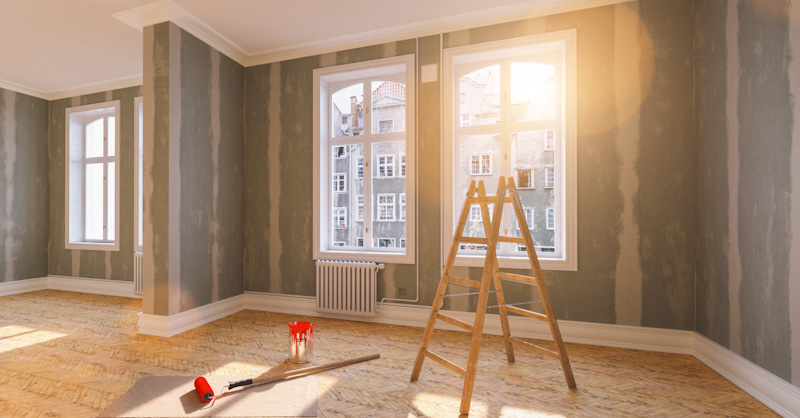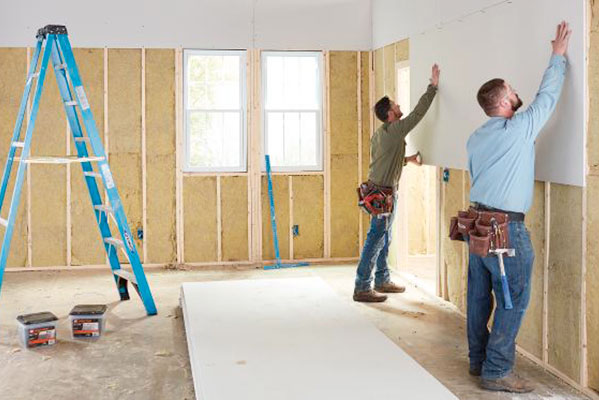Effective Drywall Repair Techniques to Recover Your Walls
Effective Drywall Repair Techniques to Recover Your Walls
Blog Article
Complete Overview to Trustworthy and reliable Drywall Installment
Drywall installment is an important element of any type of construction or renovation task, requiring a precise approach to ensure both performance and integrity. Understanding the essential devices and methods is critical, as well as identifying typical pitfalls that can bring about below average results. By carefully preparing the area and implementing ideal methods, one can achieve a perfect finish that stands the examination of time. It is necessary to explore the subtleties of each step in the procedure, as they collectively add to the overall success of the drywall installment. What particular approaches can elevate your strategy?
Necessary Devices for Drywalling
When starting a drywall setup job, having the right tools is crucial for accomplishing a professional surface. Important devices include a drywall knife, measuring tape, and a T-square, which are fundamental for precise measurements and smooth cuts. A drywall lift is also very beneficial, particularly for ceiling installations, permitting for less complicated handling of hefty panels.
For fastening the drywall, a cordless drill and drywall screws are necessary. The drill should be furnished with a drywall bit to make sure performance and accuracy. In addition, a crucial device is the drywall saw, which assists in cutting around various other barriers and electrical outlets.

Moreover, safety equipment such as safety and security glasses and a dirt mask are necessary to make sure personal safety throughout the installment process. Utilizing the right tools not just enhances the high quality of the installation yet additionally enhances the operations, making the job much more efficient total.
Preparing the Area

Next, analyze the condition of the wall surfaces and ceilings. Fix any existing damages, such as openings, fractures, or peeling off paint, to guarantee a smooth and also surface for drywall application. Furthermore, look for electrical outlets, pipes lines, and heating and cooling air ducts, marking their places to stay clear of problems throughout installment.
It is also critical to measure the area properly, identifying the measurements of the ceilings and walls to determine the ideal amount of drywall needed. Produce a thorough plan that includes the design and alignment of the drywall panels.
Installation Methods
Efficient installment techniques are vital for attaining a specialist finish in drywall projects. Appropriate dimension and cutting of drywall sheets are basic steps. Always measure the wall room accurately, permitting any switches or electrical outlets. Utilize an utility knife for clean cuts, racking up the paper face and breaking the board along the racked up line.
When hanging drywall, begin with the top and work downward, guaranteeing that the long edge of the board is perpendicular to the framing. Secure the sheets with screws rather than nails, which provide greater holding power and reduce the threat of standing out. Location screws every 12 inches along the edges and every 16 inches in the field of the board.
For corners, make use of edge grains to accomplish sharp, clean edges. When installing on ceilings, use a drywall lift or have a companion aid in holding the sheets in position (drywall contractor). Maintain a void of concerning 1/4 inch above the floor and you could try here ceiling to accommodate development and tightening
Completing Touches

Begin by applying joint tape over the joints. This can be either paper or fiberglass harmonize tape, with paper being chosen for its resilience. As go to this website soon as the tape remains in place, it's time to apply the very first coat of joint substance, likewise recognized as mud. Make use of a 10 to 12-inch taping knife to spread out the substance equally over the taped seams, feathering the sides to blend with the bordering drywall.
Enable the compound to completely dry extensively, typically 24 hours. After drying, sand the surface lightly with fine-grit sandpaper to remove any kind of blemishes. drywall contractor. Repeat the mudding and sanding process, generally two to 3 coats, ensuring each layer is smooth and flush with the drywall surface area
Common Blunders to Avoid
Several Do it yourself enthusiasts experience challenges throughout drywall setup that can endanger the final results. One typical blunder is failing to properly gauge and cut drywall sheets.
One more frequent error is improper attachment. Utilizing also few screws or nails can cause loosened drywall, while overdriving bolts can trigger the paper to tear, deteriorating the framework. It's important to preserve regular spacing, generally every 16 inches, and to make sure that bolts are flush with the surface area.
In addition, not dealing with moisture issues before installment can cause mold and mildew growth and architectural damage. Constantly webpage examine the environment and use moisture-resistant drywall in high-humidity areas.
Verdict
Reliable and dependable drywall installation requires thorough interest to detail throughout the process. By making use of crucial devices, preparing the room sufficiently, and sticking to ideal methods in installation strategies, a perfect coating can be achieved. Additionally, careful application of joint compound and tape during the completing stage improves resilience and appearance. Avoiding usual errors further contributes to an expert outcome, underscoring the importance of accuracy and method in successful drywall jobs.
It is essential to discover the subtleties of each step in the process, as they jointly add to the total success of the drywall setup.When embarking on a drywall installation job, having the right devices is essential for achieving a professional surface.For securing the drywall, a cordless drill and drywall screws are required.Appropriately preparing the room is crucial for a successful drywall installation.Efficient installation methods are important for attaining a professional finish in drywall projects.
Report this page